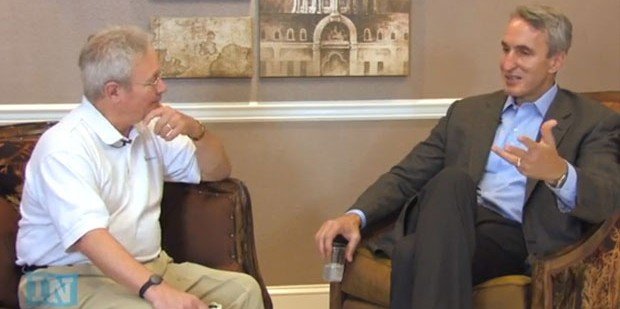Does Insulin Make Us Fat?

The history of human thought is full of some head-scratching wrong turns. For instance, how could the human race’s best thinkers once have proclaimed that the world was flat? Or that the Earth was the center of the universe?
Noted science writer Gary Taubes might have some unique insight into how science fiction comes to be regarded as science fact. Through his work as a scientific “mythbuster,” Taubes has delved into more than a century of nutrition research, and he believes popular views on obesity may be fatally flawed (see video of the full interview below).
“I kept running up against the reality that nutrition research was really quite flawed and quite incapable of making some of the claims that we have come to take as dogma,” Taubes says.
Taubes, author of Why We Get Fat And What to Do About It, spoke with Insulin Nation founding editor Chris Leach at the Diabetes + Innovation 2013 conference in Washington D.C. The way Taubes tells it, the history of obesity research is as full of as many missed connections and wrong turns as a Shakespearean tragedy. Just as we begin to truly debate the underlying causes of obesity, history provides another obstacle to our understanding.
 The dominant theory of obesity in the U.S. is that we become obese when we take in more calories than we need, a way of thinking known as the energy balance hypothesis. This theory says that a combination of too much food and too little physical activity causes us to gain weight. It’s an intoxicatingly simple idea, and one that seems aligned with our basic understanding of physics.
The dominant theory of obesity in the U.S. is that we become obese when we take in more calories than we need, a way of thinking known as the energy balance hypothesis. This theory says that a combination of too much food and too little physical activity causes us to gain weight. It’s an intoxicatingly simple idea, and one that seems aligned with our basic understanding of physics.
But even at the time of the theory’s inception, there was evidence against it, says Taubes. Researchers became aware of pockets of populations where people who were physically active and calorie-poor were prone to obesity.
“In many cases, they’re on borderline starvation,” Taubes says. “These are populations with undernutrition, stunting in children, malnutrition, deficiency diseases.”
Around the same time that researchers were trying to explain these exceptions, endocrinologists were just beginning to discover the power of hormones. Insulin was first used to control diabetes in 1923, and scientists were just beginning to understand human growth hormone around the same time. The early pioneers of insulin research knew that insulin played a significant role in fat production within the body, but many other scientists in the U.S. quickly dismissed the notion that hormone imbalance might cause obesity. Nutrition scientists worried that a hormonal explanation of obesity might let obese people off the hook, he says.
“They’re completely new to this concept, yet they’re dismissing an hormonal explanation of obesity as an excuse for a fat person not to do what lean people do,” Taubes says.
But in Europe, the theory of a hormonal underpinning for obesity was taking root. Before WWII, most serious scientific research was being done in Europe, particularly in Germany. German scientists did rigorous scientific study which seemed to suggest that obesity was tied to hormones. As evidence, they pointed to how men got heavy above the waist as their testosterone levels receded with age, while women tended to get heavier below the waist as their hormone levels shifted.
And different cells reacted differently to fat. In one celebrated 19th century case study, a child received a skin graft for a burn on the back of her hand; doctors used skin from her stomach for the graft. The child, who grew up to be obese, had a pocket of fat on the back of the hand that had received the skin graft, while her other hand was more slender. Certain cells were more prone to accumulating fat than others, and researchers speculated that certain individuals accumulated fat more than others, as well. Researchers believed hormone levels were the difference.
If European scientific inquiry maintained its hegemony over U.S. research efforts, the hormonal theory of obesity would probably be the dominant nutrition theory today. With the advent of WWII, however, everything German fell out of vogue, including the country’s scientific research. Before the war, the first U.S. texts on obesity and nutrition cited German scientific texts exclusively; by 1948, an important clinical guide to obesity barely referenced German scientists.
Into this post-WWII vacuum stepped researcher Louis Newburgh of the University of Michigan. Newburgh firmly believed in the energy balance hypothesis, and he was not the most sympathetic to the plight of the obese, Taubes says. His ideas took firm root in the small circle of influential obesity researchers in the U.S. Soon, his pronouncements were taken as gospel.
”Medicine has this kind of tendency to believe that if an authoritative figure says it, it must be true,” Taubes says.
 By the sixties, researchers had a firm understanding that insulin was key to fat accumulation in cells, and there was an opportunity to connect hormone levels to obesity. But around the same time, the American Heart Association and influential nutrition researchers began to assert that a high-fat, high-protein diet was extremely unhealthy for the heart. They pushed for a low-fat diet, which would inevitably be high in carbohydrates. If insulin was a key player in fat accumulation, a carb-rich diet which would spark insulin production in the body would inevitably do nothing to combat obesity. The low-fat dietary recommendation became the dominant theory for several decades, despite a lack of clear evidence of its worth, Taubes asserts.
By the sixties, researchers had a firm understanding that insulin was key to fat accumulation in cells, and there was an opportunity to connect hormone levels to obesity. But around the same time, the American Heart Association and influential nutrition researchers began to assert that a high-fat, high-protein diet was extremely unhealthy for the heart. They pushed for a low-fat diet, which would inevitably be high in carbohydrates. If insulin was a key player in fat accumulation, a carb-rich diet which would spark insulin production in the body would inevitably do nothing to combat obesity. The low-fat dietary recommendation became the dominant theory for several decades, despite a lack of clear evidence of its worth, Taubes asserts.
“Study after study after study failed to confirm that a low-fat diet is a healthy diet,” Taubes says.
There were those who challenged the importance of a low-fat diet, including Dr. Robert Atkins, a brash cardiologist who touted a high-fat, high-protein diet that curtailed carbs. Atkins grew famous touting the diet as a delicious way to stay slim, and the “Atkins diet” became a craze. But Atkins also angered the nutrition research community by impolitely opposing established doctrine, Taubes says.
”He was certainly sticking it in their faces,” he says.
Taubes believes that many researchers have taken a “baby and the bathwater” approach to Atkins’ ideas, discounting the concept of a high-fat, high-protein diet because of its loudest messenger. He also believes the connection between insulin levels and obesity has not gotten its full day in court. This is a tragedy, he says, because it silences needed debate on nutrition.
“Imagine someone walked into the room here and he was 8 feet tall, and we weren’t allowed to talk about growth hormone because some doctor we thought was a quack had blamed excess growth on growth hormone,” he says.
To combat this, Taubes and others recently formed the Nutrition Science Initiative, a well-funded nonprofit designed to facilitate experiments aimed at resolving what makes a healthy diet. The goal is to allow scientists the funding necessary to carry out rigorous in-patient short studies and carefully-controlled outside-the-clinic longer studies of various diets. Only then will we be able to say for sure what makes up a diet that combats obesity, Taubes says.
“These kinds of studies, they have to be done, and they have to be done better than they have in the past,” he says.
Thanks for reading this Insulin Nation article. Want more Type 1 news? Subscribe here.
Have Type 2 diabetes or know someone who does? Try Type 2 Nation, our sister publication.







